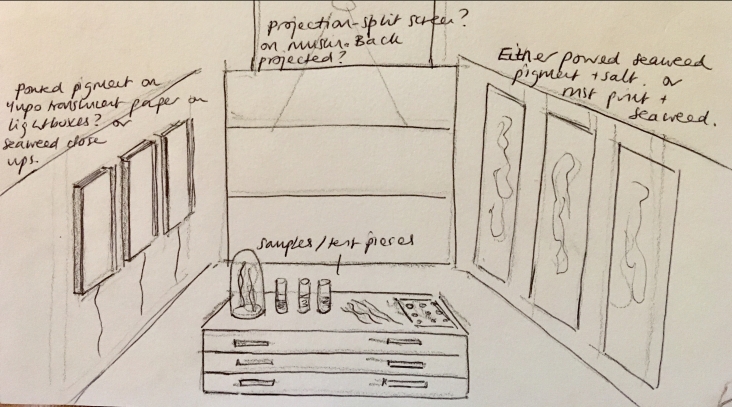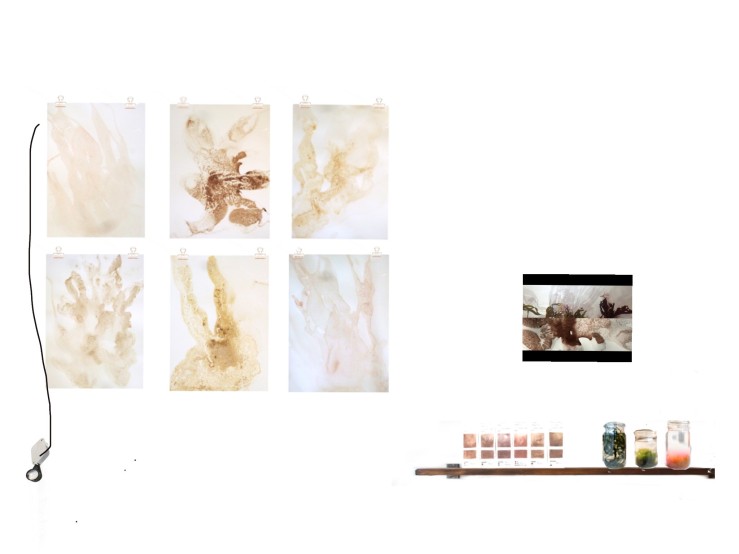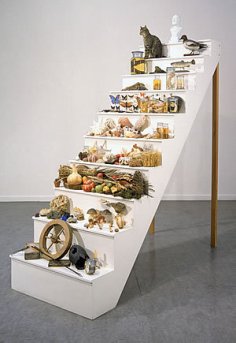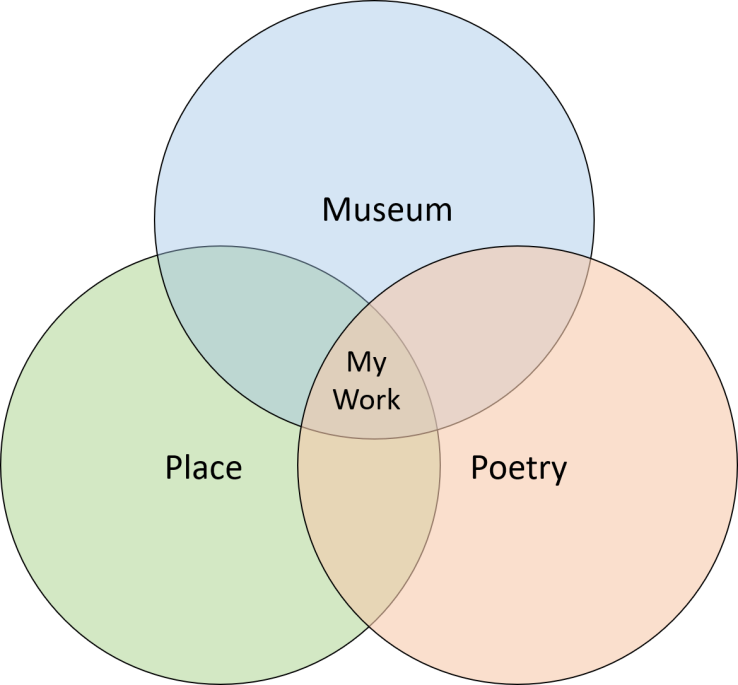
The sketch on the left was produced last month and shared in the March crit. In discussion with the group and Les there was a feeling that the large seaweed pigment works and split screen projection could work alone. Les questioned whether the other elements were necessary or merely describing the rest of the work.
Since this point I have moved away from using a large scale projection and large scale work in favour of creating a more intimate collection, an accumulation of smaller pieces. My tutorial with Michele Whiting on 1st April was really useful in getting me to address the form of installation I am creating. I had presented the idea of using a neat grid and shelf (as sent to The Civic and signed off by the other tutors):-

There is something neat, orderly and clinical in the above arrangement. Michele commented on the significance of the grid as a form of taxonomy and how I had not really addressed this in my blog and that it required research and inclusion in my essay. She also redirected me to Mark Dion’s work on collecting and museology (I had researched his work in Year 1), pointing out that his process was highly relevant to the work. Michele questioned whether I want to create something that can be neatly contained and appears to be finished, or something which provokes more questions, is hard to contain and is inherently ‘slippery’ and unfinished. To quote Michele’s comments from my notes:
But one of the valuable parts of the process, the experimentation, repeat visits, understanding place, ways of looking and working. To make this explicit have to grasp that all the processes are the work. Argument for making the process and research explicit. Think about how the women collecting seaweed collated their albums, went every day, made drawings, recorded the seaweed, pressed seaweed – I’m doing the same. The grid can still come into it, look back at Mark Dion’s work – collecting the material was part of the work.
The above comments made sense to me, my project has been an ongoing process of collecting, processing, responding. As with Dion who reveals and unpicks the processes of collecting and also reveals the workings behind the scenes of museums and archives, I could also make my process of collecting and selection explicit.
https://glasstire.com/2018/07/24/amon-carter-to-present-installation-by-mark-dion-in-2020/ (accessed April 5th 2019) In the above work, Dion is retracing the journeys of 19th century Texan explorers. There is a sense in which I am retracing, not the journeys but the processes, of my seaweed collecting ancestor and other seaweed collectors/ phycologists, including Amelia Griffiths, Mary Wyatt, Margaret Gatty and Anna Atkins.
Making the maquette above was a useful process and helped me to visual the installation and consider the layout. It has been confirmed that I have a long wall and corner in The Civic so the installation might not be in a straight line. I was thinking of representing a taxonomy in the arrangement of work on paper (as in the maquette above), starting with poured ink images of each of the main types of seaweed at the top and getting gradually smaller. I think this is a bit too neat and contained so I will vary the sizes and arrangement to add more variety and make it appear more informal/ personal.
Dion’s installations are highly detailed and thought through, they are convincing – putting us in the shoes of an explorer/ collector. His work focuses on the taxonomy and categorisation used in museums and archives. He predominantly works within institutions and responds to their collections. His work is also playful and often making an environmental point and holding a spotlight to our approach to the environment and collecting. “Mark Dion approaches history with both humor and respect while embodying the artist-explorer experience in modern times. He is able to push the boundaries of what a normal exhibition looks like, but still makes it accessible to a wide audience by creating a sense of wonder.” Margaret C. Adler, curator at The Amon Carter Museum of American Art in Fort Worth. https://glasstire.com/2018/07/24/amon-carter-to-present-installation-by-mark-dion-in-2020/ (accessed April 5th 2019) In the above work, Dion is retracing the journeys of 19th century Texan explorers. There is a sense in which I am retracing, not the journeys but the processes, of my seaweed collecting ancestor and other seaweed collectors/ phycologists, including Amelia Griffiths, Mary Wyatt, Margaret Gatty and Anna Atkins.
Following the discussion with Michele about revealing the research and processes I tried out a mock up for the exhibition in my studio today (above). The space is not quite as big as the space I’ve been allocated in the gallery. I sourced a bureau desk on Ebay – as a desk represents research more than the shelf that I had showed in my proposal, it also provides the opportunity for the viewer to look more closely, reveals more of the process. The desk will include seaweed and ink samples, my sketchbook with pigment tests and notes, and examples of pressed seaweed.
The above comments made sense to me, my project has been an ongoing process of collecting, processing, responding. As with Dion who reveals and unpicks the processes of collecting and also reveals the workings behind the scenes of museums and archives, I could also make my process of collecting and selection explicit.

Dion’s installations are highly detailed and thought through, they are convincing – putting us in the shoes of an explorer/ collector. His work focuses on the taxonomy and categorisation used in museums and archives. He predominantly works within institutions and responds to their collections. His work is also playful and often making an environmental point and holding a spotlight to our approach to the environment and collecting. “Mark Dion approaches history with both humor and respect while embodying the artist-explorer experience in modern times. He is able to push the boundaries of what a normal exhibition looks like, but still makes it accessible to a wide audience by creating a sense of wonder.” Margaret C. Adler, curator at The Amon Carter Museum of American Art in Fort Worth. https://glasstire.com/2018/07/24/amon-carter-to-present-installation-by-mark-dion-in-2020/ (accessed April 5th 2019) In the above work, Dion is retracing the journeys of 19th century Texan explorers. There is a sense in which I am retracing, not the journeys but the processes, of my seaweed collecting ancestor and other seaweed collectors/ phycologists, including Amelia Griffiths, Mary Wyatt, Margaret Gatty and Anna Atkins.
Michele encouraged me to create a scale maquette to test out the form and scale of the installation:
‘The effort to organise and explain the world’s copious and strange complexity is the desire underlying the Wunderkammer – but equally evident is the desire to luxuriate in what cannot be understood. Even if we have, today, split apart the scientific from the artistic, the Wunderkammer reminds us that the two are both essentially forms of taking pleasure in the task of understanding the world, provoked by a stimulating object or idea.’ Obrist, H. and Raza, A. (n.d.). Ways of curating. (2014). UK: Penguin Random House. p.42
Work on paper – there will be quite a lot of variety in terms of scale and materials/ processes. This fits with the idea of it being a personal collection and – as with the seaweed albums at the RAMM archive, several types of paper were used, depending on availability and wealth of the collector.
I have hung the work on paper from twine – again, an alteration from my proposal, there will also be a larger number of pieces of varied scale, with a slightly more jumbled appearance than in the photos. The work on paper represents the different approaches that I have taken in my research, it also reveals my personal response to the material.
I testing out different ways that I could show my film, one thought was to show it in one of the drawers of a small apothercarie’s chest that I own (middle image in top row). I like this idea – in particular with the drawer being partially opened, the viewer has to pull it open. It doesn’t work on the plinth I have shown in the photo, it’s too high here, might work better on a side table. Alternatively I could use a plinth, as in right hand image on top row – perhaps rather than having an aperture cut out of the front I would cut one out of the top so that the viewer is peering down into it, as you would into a rock pool. TBC. I will probably need to get this fabricated by a CNC cutter if I go for the plinth option to make it look really crisp.
Michele suggested I read Hans Ulrich’s Ways of Curating and Claire Bishop’s Installation Art to help develop my understanding of the history and context, as well as opportunities and implications of particular forms of installation art. I found Ulrich’s writing particularly enjoyable and relevant – he comments on a conversation between Umberto Eco and Jean-Claude Carriere ‘during which they discuss archives, the writers say that everything they’ve thought about such collections started with their childhood’. Obrist, H. and Raza, A. (n.d.). Ways of curating. (2014). UK: Penguin Random House.p.46. This chimes with my experience of seaweed collecting, with photos and stories of me digging around in rockpools and seaweed aged five. Another quote by Ulrich especially attracted my attention:
‘The effort to organise and explain the world’s copious and strange complexity is the desire underlying the Wunderkammer – but equally evident is the desire to luxuriate in what cannot be understood. Even if we have, today, split apart the scientific from the artistic, the Wunderkammer reminds us that the two are both essentially forms of taking pleasure in the task of understanding the world, provoked by a stimulating object or idea.’ Obrist, H. and Raza, A. (n.d.). Ways of curating. (2014). UK: Penguin Random House. p.42
 Through writing my essay, and examining ideas of taxonomy, as well as the work of Mark Dion, I decided to add a ladder to my installation. This ‘Seaweed Collectors of The British Isles‘ ladder (pictured above) includes the names of the female collectors that I have researched – Amelia Griffiths, Mary Wyatt, Anna Atkins, Margaret Gatty, and my Great, Great Grandfather John Mann, whose album started off my investigation in the first place. This is not supposed to be a comprehensive list, but the figures who have shaped my enquiry. I have written their names and dates on each rung. Dion’s Scala Naturae, (1994). The ladder is a metaphor for ordering and in my work for change/ revision as there is an implicit invitation to the viewer to climb it and move the installation. It is also intended to suggest the ongoing nature of collecting and ordering.
Through writing my essay, and examining ideas of taxonomy, as well as the work of Mark Dion, I decided to add a ladder to my installation. This ‘Seaweed Collectors of The British Isles‘ ladder (pictured above) includes the names of the female collectors that I have researched – Amelia Griffiths, Mary Wyatt, Anna Atkins, Margaret Gatty, and my Great, Great Grandfather John Mann, whose album started off my investigation in the first place. This is not supposed to be a comprehensive list, but the figures who have shaped my enquiry. I have written their names and dates on each rung. Dion’s Scala Naturae, (1994). The ladder is a metaphor for ordering and in my work for change/ revision as there is an implicit invitation to the viewer to climb it and move the installation. It is also intended to suggest the ongoing nature of collecting and ordering.
The form of my installation has evolved, through discussion, research and my making. I hope that it now invites more participation and engagment from the viewer than my earlier proposal and presents a questioning and curious collection. I imagine it will provoke a range of responses in the viewer. Primarily I aspire to invite a sensory and personal response and create discussion around collecting, observation of nature, materials, ephemerality vs permanence, and the role of the female collector.
















